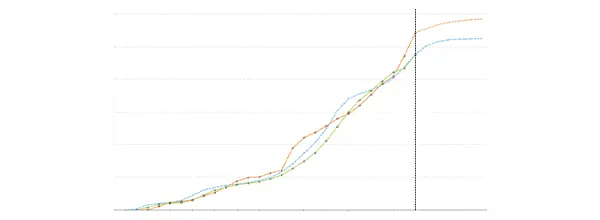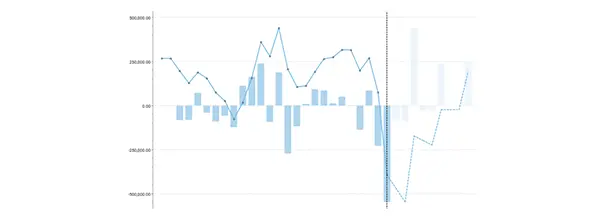
Controlling costs remains one of the toughest challenges in construction projects. Without clear insight into when and where costs will happen, even well-planned projects risk overruns and cash flow problems. A time-phased budget gives project teams a clear roadmap for how costs will unfold over time, making it easier to plan ahead, track performance, and take action before small issues escalate. Integrated project controls software help simplify this process by bringing budgets, schedules, and actual costs together in a single system.
This blog explains what a time-phased budget is, why it matters, and how construction teams can build one that keeps costs aligned with real project progress.
Table of Contents
- What Is A Time-Phased Budget in Construction?
- Benefits of Time-Phased Budgeting
- Considerations When Setting Up A Time-Phased Budget
- Steps To Create a Time-Phased Budget
- Common Challenges And How To Overcome Them
- Time-Phased Budget VS. Cost-Loaded Schedule
- Tools and Software for Time-Phased Budgeting
What Is A Time-Phased Budget in Construction?
A time-phased budget divides the total project budget into time-specific allocations that align with the project schedule. It acts as a cost control budget phased over time, often visualized with an S-curve to show when funds will be spent during the project lifecycle.
This method supports the creation of a Performance Measurement Baseline (PMB), which is used to plan, monitor, and report project costs and progress. By comparing actual costs to planned values, teams can detect deviations early and take corrective action to keep the project on schedule and within budget.
Benefits of Time-Phased Budgeting

Figure 1: Planned vs. Actual S-curve with Forecast
Implementing a time-phased budget in construction gives project teams greater control and clearer insight into spending over time. Here’s how it helps:
- Stronger Performance Tracking & EVM: A time-phased budget forms the backbone of the Performance Measurement Baseline (PMB), integrating cost, schedule and scope baselines. This foundation supports earned value analysis by comparing planned and actual performance, allowing reliable forecasting and early identification of deviations.
- Enhanced Budget Visibility: A time-phased budget links planned costs to the project’s Work Brakdown Structure (WBS) and aligns them with the schedule. This gives budget data real-world context, showing not just how much will be spent, but when and on what scope of work. As a result, teams gain clear visibility into how the budget translates into construction progress and cost exposure over time.
- Optimized Cash Flow Management: A clear forecast of when funds are needed helps construction teams plan working capital wisely. This keeps cash flow aligned with project needs and avoids tying up funds unnecessarily.
- Supports Resource Planning: While resource loading is generally handled within the project schedule, time-phased budgeting complements it by clarifying when the costs associated with labor, materials, and equipment will occur. This supports better timing for procurement and helps identify and reduce idle time or resource-related cost overruns.
- Proactive Risk Mitigation: Since time-phased budgets highlight financial deviations early in the project lifecycle, project teams can address issues before they escalate.
- Data-Driven Decision-Making: Better project visibility enables informed and proactive decision-making. Teams can adjust resources, manage scope changes, and act timely to keep the project on track and within budget.
- Improved Stakeholder Communication: A clear, time-phased view of planned versus actual costs helps project teams report trends, justify budget changes, and manage expectations. It supports more transparent communication with clients, executives, and other stakeholders throughout the project lifecycle.
Considerations When Setting Up A Time-Phased Budget
Setting up a time-phased budget begins with defining a clear Work Breakdown Structure (WBS). The WBS defines the scope of work and provides the framework to assign and map costs to specific activities and time periods.
When you have your WBS and project schedule in place, you can assign spending profiles to activities based on when work will occur. These profiles may vary based on your contracting strategy. For instance, milestone payments will result in stepwise cost accumulation, while monthly progress payments will smooth out expenses.
Aligning your planned costs with both the project schedule and contract terms results in a more accurate spending curve, which helps track and forecast costs over time.
Steps To Create a Time-Phased Budget
To create a time-phased budget, follow these steps:
1. Define Your Project Scope
Start by clearly defining the project’s deliverables and structure. Break the total scope into manageable work packages using a WBS. This framework organizes all project elements and serves as the foundation for cost estimating, scheduling, and control.
2. Detailed Estimating
Develop detailed cost estimates for each work package based on the defined scope. Include direct costs such as labor, materials, equipment, and subcontracting. Leverage historical data, cost databases, or benchmarking tools to improve accuracy, and include contingencies where appropriate.
For indirect costs (e.g., site overhead, temporary facilities) and contingency, which are not easily tied to individual work packages, estimate them at a higher level – such as per WBS branch or at the total project level. These costs can later be time-phased logically based on drivers like duration or resource intensity.
3. Build the Project Schedule
Construct a detailed, logic-driven schedule that shows when each work package will be executed. Activities should be time-bound and tied to the WBS.
The cost estimate — especially labor hours, equipment usage, or crew productivity — should inform the expected duration of activities. This ensures that time and cost are aligned from the start, improving the reliability of both the schedule and the time-phased budget.
Whether organized by week, month, or project phase, the schedule must reflect the actual sequence and duration of work to serve as a reliable input for cost phasing.
5. Establish the Performance Baseline
Once the time-phased budget is finalized, integrate it with the defined scope and schedule to form the Performance Measurement Baseline (PMB).
The PMB acts as the official reference for tracking and controlling project performance. While the time-phased budget shows how much will be spent and when, the PMB ties this financial plan to specific deliverables and scheduled work, enabling earned value management and variance tracking. Once established, the PMB should only be revised through formal change control.
6. Monitor Actual Costs and Progress
During execution, track actual costs incurred and measure physical progress regularly. Use integrated tools to capture and align this data with the control accounts or WBS. Timely and accurate updates are key to ensuring the budget reflects the project’s real-time status.
7. Analyze Variances and Reforecast
Compare actual results with the PMB to identify cost or schedule variances. Investigate the root causes of deviations and, if necessary, reforecast future costs or reallocate remaining budgets. Transparent adjustments keep the project financially controlled and decision-making informed.

Figure 2: Cash flow over time
Common Challenges And How To Overcome Them
Even with a well-prepared plan, time-phased budgeting comes with its own set of challenges. Here are three common issues and practical ways to overcome them:
1. Inaccurate Cost Estimates
Time-phased budgets based on inaccurate cost estimates can quickly lead to budget overruns and costly rework later in the project.
Solution: Make sure the accuracy of your estimates matches the level of project definition. Early conceptual estimates should include more contingency and allowance and rely on analogous or parametric data, while detailed estimates later in the project can be more precise and activity based.
Use historical data from similar past projects to refine your estimates. Leverage reliable cost databases and knowledge bases, like CESK, to benchmark material and labor costs against industry standards. Involve experienced estimators and subject matter experts to validate assumptions and add contingencies appropriately to the estimate maturity and known risks.
2. Fragmented Budget Tracking
Effective time-phased budgeting requires bringing together actual cost data, progress updates, and other critical project information. Yet, this data is often scattered in separate spreadsheets or disconnected tools, which increases the risk of outdated and inaccurate information. Precision is key as even small errors can quickly grow into costly discrepancies. As projects become more complex, keeping the time-phased budget up to date can feel daunting without the right tools and processes in place.
Solution: Make sure your project has a clear and consistent Work Breakdown Structure (WBS) as a backbone for linking costs, schedules, and performance data. Then, implement an integrated project controls solution that combines cost, schedule, and progress information in one place. Use automated updates where possible to minimize errors and ensure your budget always reflects your project’s real status. Having a strong WBS and having real-time visibility into planned vs actual costs will help you spot potential issues early, so you can respond proactively.
3. Changing Project Conditions and Scope
Construction projects are highly susceptible to unforeseen events, shifting client requirements, and external factors that can impact the project’s scope, timeline, and costs. Unexpected design changes, evolving site conditions, labor shortages, or material delays can quickly make your original time-phased budget outdated.
Solution: Put a robust change control process in place to assess the cost and schedule impact of every proposed change. Build contingencies into your initial budget to create a flexible time-phased framework that can be adapted when needed. Once changes are approved, promptly update the budget and schedule to keep them accurate. Lastly, transparently communicate to stakeholders these evolving conditions so that they understand how they may affect project costs and timelines.
Time-Phased Budget VS. Cost-Loaded Schedule
A time-phased budget and a cost-loaded schedule are closely related but serve different purposes and operate at different levels of detail.
A cost-loaded schedule assigns estimated costs directly to the activities in the project schedule. Each task or work package includes its expected costs for labor, materials, equipment, and other resources. Thus, a cost-loaded schedule gives project teams a clear picture of how costs will be incurred as work progresses.
A time-phased budget takes this detailed cost and schedule information to allocate the total project budget across defined periods (e.g., weeks, months, or phases). This higher-level view shows how the total budget will be spent over time and acts as the basis for tracking planned versus actual costs and measuring project performance.
In practice, the cost-loaded schedule feeds the time-phased budget, which then becomes part of the Performance Measurement Baseline (PMB) used for earned value management. While the cost-loaded schedule is activity-focused and tightly linked to task-level planning, the time-phased budget provides the structure needed for budget visibility, variance tracking, and long-term financial control.
Tools and Software for Time-Phased Budgeting
While you could build a time-phased budget in spreadsheets, tracking and updating it manually can quickly become overwhelming and lead to errors. Instead, many project management tools, like MS Project or Primavera P6, help automate much of this process and keep data up to date in real time. For more advanced control, integrated project controls tool like Cleopatra Enterprise combines estimating, scheduling, and cost management in one platform, so teams can keep budgets accurate and aligned with actual project progress.
According to Dodge Construction Network’s survey, 70% of owners and contractors agree that better communication and coordination across…
Operational efficiency in project management is about achieving more with less: delivering projects on time and within budget…
Related resources

What Is a Work Breakdown Structure (WBS) and Why Is It Important?
A well-defined Work Breakdown Structure (WBS) forms the cornerstone of every high-performing cost control department. It gives a clear structure that links project scope, cost, and time. This ensures that every deliverable is well-defined and easy to track during the project. In this article, we’ll explore what a WBS is,…
Read blog article
An Earned Value Management (EVM) Guide
Scope creep, budget constraints, and aligning actual work with planned tasks are just a few of the challenges faced by project managers. Ever wondered how amid these obstacles project managers keep track of progress effectively? Earned Value Management (EVM) is their not-so-secret weapon. Understanding EVM's significance is crucial; it not…
Scope creep, budget constraints, and aligning actual work with planned tasks are just a few of the challenges…
Read blog article